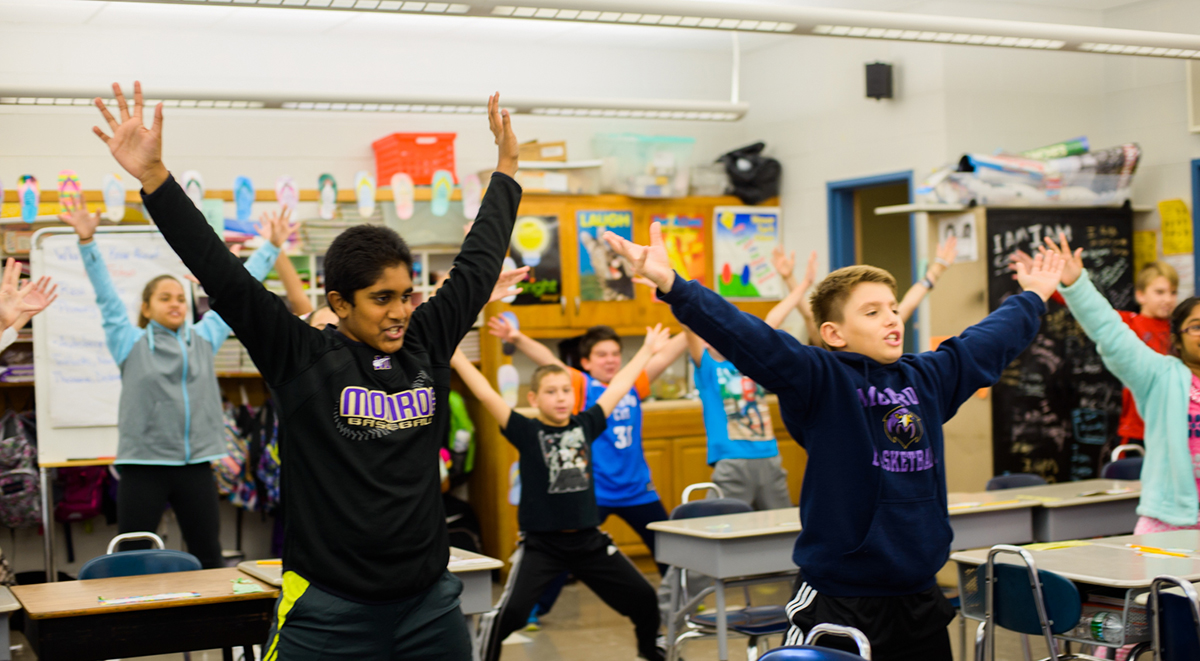
|
Start your Yoga and Mindfulness in the Classroom journey today! Sign Up Now!
|

Monday, October 19, 2015 (Updated July 2021)
According to recent national surveys, there is currently a large and growing burden of psychological disorders such as depression, anxiety and substance abuse in our youth that is almost universal. In addition to this, a significant percentage of youth are obese and at risk for lifestyle diseases such as type 2 diabetes. Furthermore, behavioral problems such as physical inactivity, bullying, and school dropouts are becoming commonplace. Key factors contributing to these problems are the inability of youth to cope with the chronic stress of modern society and a lack of mind-body awareness. Unfortunately, the focus of our school system has been exclusively on academic performance and preparing children to succeed in the adult job market, and it has essentially ignored the teaching of life skills such as stress and emotion regulation that would represent an education of the whole child.
 Yoga includes practices designed to calm the nervous system and is ideally suited to alleviate the stressors faced by students. It represents a lifelong skill that can be learned and applied over a short period of time. Furthermore, yoga promotes mind-body awareness that can lead to sustainable and long-term positive changes in behavior. It is therefore logical and likely that school-based yoga interventions may have a preventive impact, targeting early risk factors for physical and psychological disorders and negative behaviors.
Yoga includes practices designed to calm the nervous system and is ideally suited to alleviate the stressors faced by students. It represents a lifelong skill that can be learned and applied over a short period of time. Furthermore, yoga promotes mind-body awareness that can lead to sustainable and long-term positive changes in behavior. It is therefore logical and likely that school-based yoga interventions may have a preventive impact, targeting early risk factors for physical and psychological disorders and negative behaviors.
Remarkably, the implementation of grassroots yoga programs in public schools by both individuals and by formal yoga in school organizations offering school-specific yoga curriculums has actually become a movement. In a paper recently accepted for publication (update: published Fall, 2015) in the journal Advances in Mind-Body Medicine (School-Based Yoga Programs in the United States: A Survey by Butzer B, Ebert M, Telles S, and Khalsa SBS), a survey of this yoga in schools programs across the U.S. was conducted. The study identified and characterized 36 programs that have been offering yoga in over 940 schools and have formally trained over 5,000 instructors in their curricula. To be included in the analysis in this study, yoga in school programs had to include yoga physical postures and exercises and/or yogic breathing practices, but virtually all also included relaxation techniques and meditation/mindfulness practices. The study analyzed each program’s scope of work, curriculum characteristics, teacher certification, and training requirements, implementation model, mode of operation, and primary geographical region.
All programs were designed to be secular and teach universal values or life skills, which makes them suitable for public school settings. Most programs also included aspects beyond the physical by incorporating ethics or philosophy in their lessons. Several additional activities were also included in a number of these programs. Games, songs, journaling, crafts, and team-building exercises that would not typically be considered yoga per se are common auxiliary learning tools that have been seamlessly woven into the yoga lessons. The inclusion of those non-traditional components allows the yoga programming to be integrated with school values and social and the few social and emotional learning programs already in existence.
In recognizing the need for this social and emotional component, the Collaborative for Academic, Social and Emotional Learning (CASEL) has been promoting the inclusion of social and emotional learning in schools. Although the many school-based yoga and mindfulness programs have no formal relationship to the CASEL, many of the program goals are aligned with the core CASEL competencies of enhancing students’ self-awareness, self-management, social awareness, relationship skills, and responsible decision-making.
The yoga in schools movement is an appropriate countermeasure for the current challenges in our youth’s health and behavior and should lead to improved social and emotional skills, classroom behavior, and academic performance. An increasing number of peer-reviewed research studies are being published, quantifying and documenting these benefits which provide policymakers with the justification to support the widespread implementation of yoga (and mindfulness and meditation) in our school curricula.
Article excerpts (with some minor updates) have been reprinted with permission. The full original article was published in the Kundalini Research Institute Newsletter, September 2015, written by former Yoga 4 Classrooms Trainer, Nikhil Ramburn, and well-known yoga researcher, Sat Bir Singh Khalsa, Ph.D., co-author of our published research study.
| Cookie | Duration | Description |
|---|---|---|
| cookielawinfo-checkbox-analytics | 11 months | This cookie is set by GDPR Cookie Consent plugin. The cookie is used to store the user consent for the cookies in the category "Analytics". |
| cookielawinfo-checkbox-functional | 11 months | The cookie is set by GDPR cookie consent to record the user consent for the cookies in the category "Functional". |
| cookielawinfo-checkbox-necessary | 11 months | This cookie is set by GDPR Cookie Consent plugin. The cookies is used to store the user consent for the cookies in the category "Necessary". |
| cookielawinfo-checkbox-others | 11 months | This cookie is set by GDPR Cookie Consent plugin. The cookie is used to store the user consent for the cookies in the category "Other. |
| cookielawinfo-checkbox-performance | 11 months | This cookie is set by GDPR Cookie Consent plugin. The cookie is used to store the user consent for the cookies in the category "Performance". |
| viewed_cookie_policy | 11 months | The cookie is set by the GDPR Cookie Consent plugin and is used to store whether or not user has consented to the use of cookies. It does not store any personal data. |